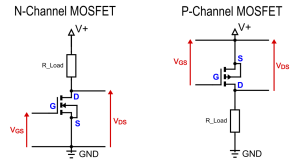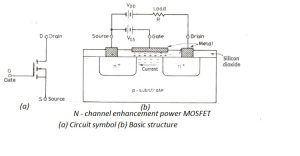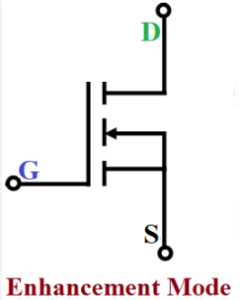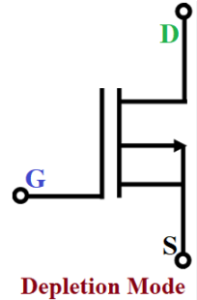
MOSFET: Types, Working Principles and Applications
August 14 2023  2039
2039
Inquiry
Global electronic component supplier AMPHEO PTY LTD: Rich inventory for one-stop shopping. Inquire easily, and receive fast, customized solutions and quotes.
QUICK RFQ
ADD TO RFQ LIST
In this blog, what a MOSFET is and how it works, as well as its applications, will be discussed. Doing this to enhance the understanding of MOSFET and electronic components.
What is A MOSFET?
A MOSFET (Metal-Oxide-Semiconductor Field-Effect Transistor) is a type of transistor widely used in electronic devices and integrated circuits. It is a three-terminal device that controls the flow of electric current between the source and drain terminals using an electric field generated by the voltage applied to the gate terminal. The structure of a MOSFET consists of a semiconductor channel, typically made of silicon, which connects the source and drain terminals. The channel is separated from the gate terminal by a thin layer of insulating material, usually silicon dioxide (SiO2). This insulating layer is commonly referred to as the gate oxide. The operation of a MOSFET is based on the principle of a field-effect transistor. When a voltage is applied to the gate terminal, it creates an electric field that modulates the conductivity of the channel region. The MOSFET has three different operating modes: cutoff, triode, and saturation. In the cutoff mode, no current flows between the source and drain terminals because the channel is effectively turned off. When a voltage is applied to the gate terminal and exceeds a certain threshold voltage, the MOSFET enters the triode mode. In this mode, the channel conducts current, and the amount of current is proportional to the gate-source voltage. Finally, when the gate-source voltage is sufficiently high, the MOSFET enters saturation mode. In saturation, the channel is fully enhanced, and the MOSFET exhibits its maximum current-carrying capability. MOSFETs are used in a wide range of applications, including amplifiers, switches, voltage regulators, memory cells, and microprocessors. They offer advantages such as high switching speeds, low power consumption, small size, and high input impedance, making them essential components in modern electronic systems.Types of MOSFET Transistor
There are several types of MOSFETs (Metal-Oxide-Semiconductor Field-Effect Transistors), each designed for specific applications and operational characteristics. N-Channel MOSFET: This type of MOSFET has an N-type channel between the source and drain terminals. It conducts current when a positive voltage is applied to the gate terminal. P-Channel MOSFET: In contrast to N-channel MOSFETs, P-channel MOSFETs have a P-type channel. They conduct current when a negative voltage is applied to the gate terminal.




How Does A MOSFET Work?
A MOSFET is a three-terminal semiconductor device that controls the flow of electric current between the source and drain terminals using an electric field generated by the voltage applied to the gate terminal. Let's explore how a MOSFET works in more detail:Structure
A MOSFET consists of a semiconductor channel, typically made of silicon, that connects the source and drain terminals. The channel is separated from the gate terminal by a thin insulating layer, usually, silicon dioxide (SiO2) referred to as the gate oxide. On top of the gate oxide, a conductive material, typically a metal or highly doped polysilicon, forms the gate electrode.Operation Modes
The MOSFET operates in three different modes: cutoff, triode, and saturation. Cutoff Mode: In this mode, the MOSFET is turned off, and no current flows between the source and drain terminals. The channel acts as an insulator, preventing the flow of electrons. Triode Mode (Linear Region): When a voltage is applied to the gate terminal, it creates an electric field that attracts or repels charges in the channel, forming a conductive path. In the triode mode, the MOSFET operates as a variable resistor, and the current flowing between the source and drain is proportional to the gate voltage. The MOSFET is not fully enhanced, and the channel is not completely conducting. Saturation Mode: As the gate voltage increases further, the MOSFET enters saturation mode. In this mode, the channel is fully enhanced, and the MOSFET acts as a low-resistance switch. It allows a maximum current to flow between the source and drain terminals.Gate Control
The MOSFET's gate terminal controls its operation. When a positive voltage (for an N-channel MOSFET) or a negative voltage (for a P-channel MOSFET) is applied to the gate terminal with respect to the source terminal, an electric field is established across the gate oxide. This electric field creates a channel in the semiconductor material, allowing current to flow between the source and drain terminals. For an N-channel MOSFET: When a positive voltage (logic high) is applied to the gate, it repels the negatively charged electrons in the channel, creating a conductive path. When a zero voltage (logic low) is applied to the gate, the channel remains non-conductive, and the MOSFET is turned off. For a P-channel MOSFET: When a negative voltage (logic low) is applied to the gate, it repels the positively charged holes in the channel, creating a conductive path. When a zero voltage (logic high) is applied to the gate, the channel remains non-conductive, and the MOSFET is turned off.MOSFET VS Transistor
A MOSFET is a type of transistor that is a broader category that encompasses several types of devices, including MOSFETs. A Bipolar Junction Transistor (BJT) is a type of transistor that operates based on the principles of electron and hole conduction in a semiconductor material. It consists of three doped semiconductor layers: the emitter, base, and collector. Here's a chart summarizing the key differences between them.| Feature | MOSFET | BJT |
| Structure | Metal-oxide-semiconductor | Bipolar junction |
| Operation Principle | Field-effect control | Current control |
| Voltage Control | Voltage-controlled device | Current-controlled device |
| Current Carrying Capability | High | Moderate to high |
| Power Dissipation | Lower power dissipation | Higher power dissipation |
| Input Impedance | High input impedance | Lower input impedance |
| Switching Speed | Fast | Moderate to fast |
| Noise Performance | Low noise | Moderate noise |
| Thermal Stability | Good | Sensitive to temperature variations |
| Gain | Voltage gain | Current gain |
| Cost | Generally more expensive | Generally less expensive |
| Applications | Digital logic, power electronics, ICs | Amplifiers, switching circuits, signal processing |
What is A MOSFET Used for?
A MOSFET is used in a wide range of electronic applications due to its unique characteristic. Here are some common uses of MOSFETs: Digital Logic: MOSFETs are extensively used in digital logic circuits, such as microprocessors, memory chips, and digital signal processors. They serve as switches, enabling or disabling the flow of current based on the voltage applied to the gate terminal. Power Electronics: MOSFETs are widely employed in power electronic applications, including power supplies, motor drives, inverters, and DC-DC converters. They can handle high power levels and efficiently switch large currents, making them suitable for controlling and converting electrical power. Amplifiers: MOSFETs can be utilized as voltage amplifiers in audio amplifiers, radio frequency (RF) amplifiers, and operational amplifiers. They provide high input impedance and low output impedance, enabling efficient signal amplification. Switching Applications: MOSFETs are commonly used as switches in various circuits. Their fast switching speeds, low on-resistance, and high current-carrying capabilities make them suitable for applications that require efficient and high-speed switching, such as power supplies, LED lighting, and motor control. RF Applications: MOSFETs designed for high-frequency operation find applications in RF circuits, including wireless communication systems, radar systems, and RF transmitters and receivers. They can handle RF signals and provide amplification or switching at high frequencies. Integrated Circuits (ICs): MOSFETs are a fundamental component of integrated circuits, which are used in a wide array of electronic devices. They play a crucial role in microprocessors, memory chips, analog circuits, and other ICs, enabling the integration of complex electronic functions into a single chip. Consumer Electronics: MOSFETs are found in various consumer electronic devices, including smartphones, tablets, televisions, audio systems, and gaming consoles. They are used in power management circuits, audio amplifiers, display drivers, and other electronic components. The versatility of MOSFETs, combined with their high switching speeds, low power consumption, compact size, and compatibility with integrated circuit fabrication processes, make them a vital component in modern electronics.Conclusion
In conclusion, MOSFETs have emerged as essential devices in the world of electronics, offering a wide range of types suited for different applications. Their working principle, based on field-effect control and the metal-oxide-semiconductor structure, allows for precise voltage control and efficient operation. MOSFETs enable fast switching speeds, high current handling, and low power consumption. Their versatility and compatibility with integrated circuit fabrication processes make them indispensable in digital logic circuits, power electronics, amplifiers, RF systems, and integrated circuits. As technology continues to advance, MOSFETs will remain a vital component, driving innovation and shaping the future of electronic devices and systems.Populer Posts
EP3C40F324C8N
Intel
5SGXEA4K2F40C2G
Intel
10M40SCE144C8G
Intel
EP2AGX45DF25I5
Intel
5SGXMB6R3F43C2G
Intel
5SEEBF45I4N
Intel
10AX115R3F40I2LG
Intel
A42MX16-PLG84
Microchip Technology
MPF500TS-1FCG1152I
Microchip Technology
